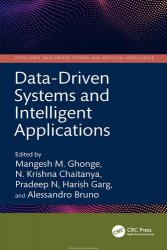 Название: Data-Driven Systems and Intelligent Applications
Название: Data-Driven Systems and Intelligent ApplicationsАвтор: Mangesh M. Ghonge, N. Krishna Chaitanya, Pradeep N., Harish Garg, Alessandro Bruno
Издательство: CRC Press
Серия: Intelligent Data-Driven Systems and Artificial Intelligence
Год: 2025
Страниц: 197
Язык: английский
Формат: pdf (true)
Размер: 12.5 MB
This book comprehensively discusses basic data-driven intelligent systems, the methods for processing the data, and cloud computing with Artificial Intelligence (AI). It presents fundamental and advanced techniques used for handling large user data, and for the data stored in the cloud. It further covers data-driven decision-making for smart logistics and manufacturing systems, network security, and privacy issues in cloud computing.
The foundation of Machine Learning is the precise use of models and algorithms. Put another way, an algorithm is just a basic procedure for making use of data, either structured or unstructured, to get a result. Concurrently, a Machine Learning model denotes the program–algorithm combination that
allows the program to achieve the required objective.
Machine Learning models encompass the broader scope of the output generated by algorithms, which are formulas for making predictions. As a result, making the claim that ML models come from Machine Learning algorithms rather than the other way around is technically correct. Viewing the models in Machine Learning will help us comprehend the function of ML algorithms.
The four primary types of Machine Learning algorithms are reinforcement learning, semi-supervised learning, unsupervised learning, and supervised learning. We provide a high-level summary of each learning approach and the extent it can be applied to real-world problems below.
Regression algorithms: The goal of regression analysis is to create a model of the relationship between the variables and then refine that model iteratively by measuring the amount of inaccuracy in its predictions. Using characteristics and a regressor, one can make predictions about the future value of a continuous variable (e.g., price or temperature). Some of the most common regression algorithms are linear regression, logistic regression, stepwise regression, locally estimated scatterplot smoothing (LOESS), and multivariate adaptive regression splines (MARS).
Instance-based algorithms: An instance-based learning model solves a decision-making issue by utilizing certain training data instances. This method typically builds a database of training data and uses a similarity measure to compare it to test data in order to find the best match and provide a prediction. Lazy learner is another term for instance-based learning method. Lazy learning waits for test data before acting upon the training data. Indolent students devote more of their time to training and less to prediction. The most popular instance-based algorithms are locally weighted learning (LWL), k-nearest neighbor (kNN), learning vector quantization (LVQ), and self-organizing map (SOM).
This book:
Discusses intelligent systems and cloud computing with the help of artificial intelligence and machine learning.
Showcases the importance of machine learning and deep learning in data-driven and cloud-based applications to improve their capabilities and intelligence.
Presents the latest developments in data-driven and cloud applications with respect to their design and architecture.
Covers artificial intelligence methods along with their experimental result analysis through data processing tools.
Presents the advent of Machine Learning, Deep Learning, and reinforcement technique for cloud computing to provide cost-effective and efficient services.
This volume comprises nine chapters, providing different advancements in data-driven systems and cloud computing through AI. Chapter 1 presents a general background of data-driven systems, discussing the challenges, architecture, and techniques used for data processing and analysis. It further highlights the key issues addressed in the proposed book. Chapter 2 describes challenges and techniques in data-driven systems. Chapter 3 discusses the role of artificial intelligence in healthcare applications using various biomedical signals. Chapter 4 describes the machine learning algorithms for data-driven intelligent systems. Chapter 5 presents an overview of cloud computing. Chapter 6 provides an overview of cloud computing for data-driven intelligent systems with AI services. Chapter 7 describes the evolution of artificial intelligence through game playing in chess: history, tools, and techniques. Chapter 8 presents the network security enhancement in data-driven intelligent architecture based on cloud IoT blockchain cryptanalysis and finally, Chapter 9 addresses geospatial semantic information modeling: Concepts and research issues.
The text will be useful for senior undergraduate, graduate students, and academic researchers in diverse fields including electrical engineering, electronics and communications engineering, computer engineering, manufacturing engineering, and production engineering.
Скачать Data-Driven Systems and Intelligent Applications